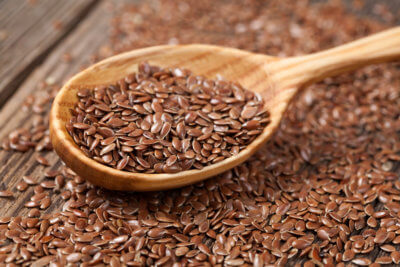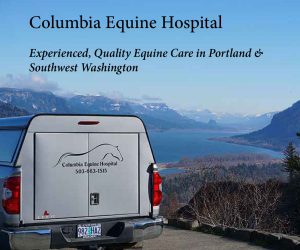Photo: Healthy pasture grasses in their growing seasons contain plenty of both omega 3 and omega 6. If your horse is lucky enough to graze on pasture much of the year, you generally do not need to concern yourself with additional supplementation. But in colder climates like the Northwest where horses are fed hay much of the winter is another story. Photo credit Cristalov.
These Essential Fatty Acids Must Be Fed Daily and in the Correct Balance
You already know that the answer is supposed to be yes. But over the years, I have found that there is a 50/50 chance this question will be answered no. Not because of neglect, but simply because many horse owners are not aware of why they’re important, or even what feeds contain them. Or they simply assume that the commercial feed they are feeding already contains enough.
But here’s the truth: most commercially fortified feeds contain more omega 6s than omega 3s, which creates an imbalance that damages your horse’s health. And that hay you’re feeding… well, it lost its omega 3 content a long time ago!
Why are Omega 3s so important?
There are only two fatty acids that are called “essential,” meaning that they absolutely must be in the diet every day because the horse’s body cannot produce them. The first essential fatty acid is an omega 6, known as linoleic acid (LA) and the other is an omega 3, known as alpha-linolenic acid (ALA). Each has specific roles but omega 3s in particular are involved in functions such as:
- Protecting the blood vessels, heart, lungs, digestive tract, bones, and joints
- Creating hormonal balance, including assisting with insulin resistance
- Promoting a healthy immune response and protecting against allergies and skin problems
- Protecting the brain against inflammatory conditions, most notably PPID (Cushing’s disease) and leptin resistance.
Not only do both omega 3s and 6s have to be in the diet, but they must be present in the proper proportion to one another. Ideally, there should be more ALA (omega 3) than LA (omega 6). In fact, if LA is higher, it will result in elevated inflammation throughout the body.
Healthy pasture grasses in their growing seasons contain, on average, plenty of both ALA and LA, in a 4:1 ratio ALA to LA. And if your horse is lucky enough to graze on pasture much of the year, you generally do not need to concern yourself with additional supplementation (unless your horse is suffering from inflammatory conditions that affect immune function, allergic responses, and chronic pain).
Supplementation for Hay-based Diets
Essential fatty acids diminish when the grass is not actively growing, so your horse likely relies on hay during the colder seasons. Year-round supplementation is necessary for horses consuming hay-based diets because once living grass is cut, dried, and stored to make hay, most, if not all, of the essential fatty acids have been oxidized and destroyed.
Your commercial feed may not be a good source of omega 3s. Most of the fat content from commercially fortified feeds is from soybean oil (sometimes called “vegetable oil”) which is extremely high in omega 6s with very little omega 3s. Some newer formulas, however, are including flax and chia seeds to improve the ratio.
Choose Organic When Feasible
Feedstuffs that are organically grown have a lower detectable level of pesticides and herbicides. Exposure to these chemicals, especially over time, can be detrimental to your horse’s heath. Interestingly, nutrients such as antioxidants and omega 3 fatty acids are more plentiful in organic plants because they aren’t oxidized by commercial chemicals.
Concentrated Sources of ALA
Ground flax or chia seeds are the most popular whole food sources for ALA. The nice thing about feeding these is that they also provide protein, thereby improving the overall protein quality of the diet. USDA certified organic versions offer the highest nutritional benefit for your horses. The following dosages are recommended:
- Ground flaxseeds: 2 ounces by weight (equivalent to 1/2 cup) per 400 pounds of body weight (120 ml per 180 kg of body weight).
- Chia seeds: 2 ounces by weight (equivalent to 1/4 cup) per 400 pounds of body weight (60 ml per 180 kg body weight).
Amounts can be reduced for overweight horses and increased for horses with special health needs.
Algal oil contains an omega 3 fatty acid called DHA. Inside your horse’s cells, ALA is converted to DHA. DHA is highly active in reducing inflammation, protecting against metabolic conditions.

Hemp seeds are interesting. The fat found in hemp seeds is excellent, although the ALA to LA ratio is inverted. There are 2.8 times more LA than ALA, so it would be useful to also include some flax or chia. But what makes the fatty acid content of hemp seeds remarkable is its gamma linolenic acid (GLA) content. GLA is an omega 6 fatty acid, but, unlike other omega 6s that increase inflammation, GLA reduces it.
Oils that are high in ALA include flaxseed oil and camelina oil. Flaxseed oil is not very easy to use. It gets sticky and oxidizes easily, making refrigeration necessary. Camelina oil comes from the edible Camelina sativa seed. It is high in ALA with a 2.4:1 ratio of ALA to LA, and its shelf life is far superior to flaxseed oil. This is because of its remarkably high vitamin E content: 100 ml (slightly less than ½ cup) of camelina oil contains 150 IU of natural vitamin E which protects the fatty acids from oxidative damage when exposed to air, humidity, and light.
Bottom line
Healthy, growing pasture grasses provide the horse with plenty of essential fatty acids in the right proportion. Diets that consist of hay, as well as most commercial feeds, are out of balance, or even devoid of the necessary omega 3 fatty acids that must be fed daily. Adding chia seeds, ground flaxseeds, or other whole foods can help your horse maintain vibrant health for a lifetime.
This article can be found with all sources noted at gettyequinenutrition.com/pages/your-horse-has-a-question-are-you-feeding-me-omega-3s-every-day
Dr. Getty’s fundamental resource book, Feed Your Horse Like a Horse, is available in paperback and Kindle versions. The paperback version is available at her website.
Find a world of useful information and a variety of quality supplements and whole foods for the horseperson at gettyequinenutrition.com: Sign up for Dr. Getty’s informative, free e-newsletter, Forage for Thought; browse her resource library of articles and tips; listen to recorded interviews; and purchase recordings of her educational teleseminars and webinars.
See this article in the November 2021 online edition:

Juliet M. Getty, Ph.D. is an independent equine nutritionist with a wide U.S. and international following. Her research-based approach optimizes equine health by aligning physiology and instincts with correct feeding and nutrition practices. Dr. Getty’s goal is to empower the horseperson with the confidence and knowledge to provide the best nutrition for his or her horse’s needs. Learn more at www.gettyequinenutrition.com.





